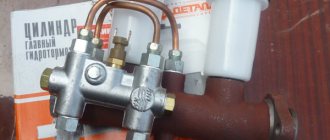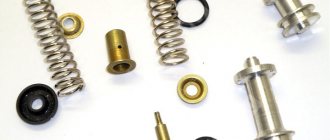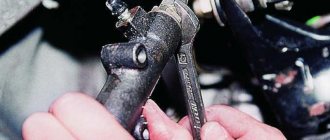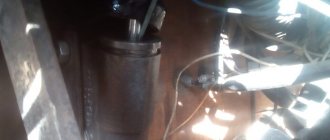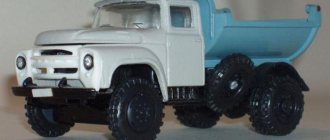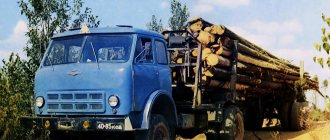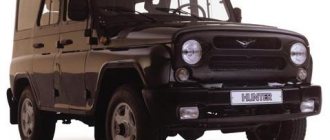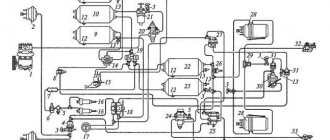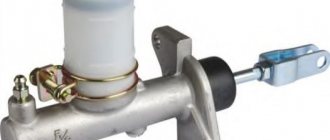MAZ-5429
Total information
| Manufacturer: | MAZ |
| Years of production: | 1977-1990 |
Design
| Body type(s): | tractor unit |
| Layout: | rear |
Engines
YaMZ-236
| Brand: | YaMZ-236 |
| Volume: | 11 150 cm3 |
| Maximum power: | 180 l. s., at 2100 rpm |
| Maximum torque: | 667 Nm, at 1250 rpm |
| Configuration: | V6 |
| Cylinders: | 6 |
| Cylinder diameter: | 130 mm |
| Piston stroke: | 140 mm |
| Compression ratio: | 16,5 |
| Cylinder operating order: | 1-4-2-5-3-6 |
Transmission
| manual 5-speed | |
| Manufacturer: | YaMZ |
| Model: | 236P |
| Type: | mechanical |
| Number of steps: | 5 |
| Gear ratios: | |
| 1st gear: | 5,26 |
| 2nd gear: | 2,90 |
| 3rd gear: | 1,52 |
| 4th gear: | 1,00 |
| 5th gear: | 0,66 |
| Reverse gear: | 5,48 |
| Switching: | floor lever |
The main gear of the drive axles is double with planetary gearboxes in the wheel hubs, the gear ratio is 7.24.
Characteristics
Mass-dimensional
| Length: | 5620 mm |
| Width: | 2500 mm |
| Height: | 2720 mm |
| Clearance: | 270 mm |
| Wheelbase: | 3950 mm |
| Rear track: | 1865 mm |
| Front track: | 1970 mm |
| Weight: | 14,515 kg |
Dynamic
| Max. speed: | 85 km/h |
On the market
| Predecessor Predecessor MAZ-504 | Successor Successor MAZ-5432 |
| Related: | MAZ-5335 |
Other
| Fuel consumption: | 22 l/100 km |
| Volume of the tank: | 200 l |
K:Wikipedia:Articles without images (type: not specified)
MAZ-5429
- a Soviet truck produced at the Minsk Automobile Plant from 1977 to 1990.
Description
The tractor cabin is radically different from its predecessor. The shape of the headlights, the radiator grille, and the shape of the cabin were changed - the era of rounded body shapes ended in the 1960s. The type of windshield has changed - it is no longer split (with a B-pillar), but panoramic. There is a new spoiler on the roof.
The “filling” of the cabin has also been changed - more and more distinct forms of steel are being produced, the control levers and the steering wheel have changed, in which, for the first time in Soviet times among trucks, there is a signal (horn), since in the previous ones it was in the form of a special cord.
Device
MAZ 5335 has a design similar to MAZ 550A. The front engine and rear-wheel drive increase the vehicle's maneuverability. The car is built on a 4 by 2 wheel design, but is equipped with extended front springs and modified telescopic shock absorbers. Due to this, vehicles without cargo confidently keep a straight lane when driving. Among other design discoveries is a modernized rear axle, made in such a way that by changing the number of teeth in the wheel gearboxes and the size of the tires, the gear ratio can be changed.
All modifications use a YaMZ-236 5-speed manual transmission with synchronizers in 2nd, 3rd, 4th and 5th gears and a 3-way circuit. The use of a dry 2-disc clutch in the transmission ensures smooth and precise gear shifting. The gear ratio of the main pair is 4.89. The main gear has planetary gearboxes in the wheel hubs. The speed selector lever is located on the floor to the right of the driver's seat. The new gearbox made it possible to increase the machine's service life to 320,000 km and reduce the labor intensity of maintenance.
MAZ 5335 turned out to be one of the first products of the Minsk Automobile Plant with a 2-circuit braking system, supplemented by separate drive along the axles. The innovation had a positive impact on traffic safety and made it possible to increase speed. The brake system was still based on drum mechanisms.
The design of the MAZ 5335 has been modified to meet international requirements. The headlights were installed in the bumper niches, which improved the illumination of the space in front of the car. Thanks to the new arrangement, there was no dazzling of oncoming drivers. The direction indicators have remained in the same place, and the radiator grille has been transformed, increasing in size.
The 3-seater cabin was quite spacious, although it provided a minimum of comfort. The seats were mounted on springs, compensating for vibrations that occur when driving over uneven surfaces. For the driver's seat, it was possible to adjust the distance to the front panel and adjust the angle of the backrest. Behind the chairs there was the possibility of equipping a sleeping place. Air conditioning was not installed in the MAZ 5335, so in hot weather the only salvation was opening the windows. The heater was listed as a basic version and was highly efficient. With it, the driver of the car was not afraid of even severe frosts. The presence of power steering simplified driving. The steering mechanism had its own 5 liter oil tank. During normal operation, lubricant was added once every 100,000 km.
The body of the MAZ 5335 has undergone major changes. A platform with metal sides was installed on the car (previously wooden sides were used). However, the poor quality of metal and paint led to rapid corrosion.
Modifications
- MAZ-504V (1976-1990) - truck tractor. Modification of the basic MAZ-5429 tractor. Designed for international and intercity transportation in the Sovtransavto system. Equipped with a YaMZ-238 engine.
- MAZ-515B (19??-19??) - truck tractor. It represented a further development of the MAZ-515A truck tractor. The cabin was used from the MAZ-5335, a new bumper with rectangular headlights was used, like the MAZ-5428.
- MAZ-5428 (19??) is an experienced truck tractor with an eight-cylinder engine.
- MAZ-5429 (1977-1990) - truck tractor. Further development of the MAZ-504A model.
- MAZ-5430 (1977-19??) - truck tractor. Designed to work with dump semi-trailers. Further development of the MAZ-504G model. Modification of the basic MAZ-5429 tractor.
SuperMAZ. The main international truck of the Soviet Union was restored in Minsk
Why suddenly write about the MAZ, which for several decades was one of the most common trucks? Yes, because MAZs of the “Super” family, despite their total prevalence, are deprived of press attention. But this car can be called, without exaggeration, the best among those produced in the USSR! Today, as part of the “Not in Trend” project, we are restoring historical justice.
A necessary prologue with a historical twist
In 1965-1990, the MAZ-500 family of trucks rolled off the assembly line of the Minsk Automobile Plant. The “Five Hundreds” replaced the first generation of “big-nosed” post-war MAZs and became the first cabover trucks in the USSR, in which the engine was located under the cab.
MAZ-504 after modernization in 1977. The car was produced in this form until 1990 under the designation MAZ-5429
Coincidentally, the birth of a new generation of Minsk trucks occurred shortly before the historic resolution of the USSR Council of Ministers of July 1, 1968 “On measures for the further development of international transportation of goods and passengers by road transport of the USSR”, in accordance with which the Main Directorate of International Road Transport was created "Sovtransavto". Branches of the organization were organized in many large cities of the USSR, including Minsk and Brest, and functioned successfully until the collapse of the Union. After 1991, in new economic and political conditions, some branches disappeared, others continued to provide cargo transportation and are still successful enterprises.
Photos from Sovtransavto advertising brochures of the 1970s. Below are Skoda LIAZ 706 cars, used in the early years of the existence of Sovtransavto for international transport along with the MAZ-504
As a result of the creation of a special structure that ensures the transportation of goods outside the USSR, it was necessary to saturate the truck fleet with vehicles of sufficient carrying capacity and power. And here it is important to note that the MAZ-504 was better suited for these purposes than any other Soviet truck. At different times during the existence of Sovtransavto, Skoda, Mercedes-Benz, and Volvo with IVECO were purchased, but in the rolling stock of the enterprises there were much fewer of them than Minsk cars.
“Lobastik”, “Murzik”, “boxer”, “stump” - these driver nicknames of the MAZ-504 reflected its main features: the cabin design, original for that time, and the rigidity of the ride (the driver and passenger seats were located exactly above the front wheels). Throughout the 70s, the 504 was the only Soviet car that had the “right to travel” abroad.
Photo from the personal archive of Nikolai Fedorovich Nagikh, a truck driver with 30 years of experience. MAZ-5429 on a par with Mercedes-Benz 2232
Generation Next and interpretation of the name “Super”
Long before the appearance of revolutionary new models of passenger cars, USSR factories in Minsk set out to make a truck that would “go to Europe.” International requirements of that time for safety, noise levels, placement of lighting equipment on trucks and many other aspects played an important role in the rapid (by Soviet standards) development of new models. As a result, 35 years ago, on May 19, 1981, the first new generation tractor MAZ-5432 was assembled at the Minsk Automobile Plant, and a year later the three-axle tractor MAZ-6422 went into production. Before the collapse of the USSR, these road trains were the only Soviet trucks that met international standards, which made it possible to use them for international transportation of goods both in Scandinavia and in other European countries.
Drivers throughout the USSR unanimously called the new family of trucks “Super.” The name stuck and became a household name, like a photocopier. The origin of this nickname does not have an unambiguous interpretation, just as we still do not know exactly what word the name of the city of Minsk came from. There are two equally probable points of view on the origin of the name “Super”: conventionally “official” and popular. According to the first version, the “Super” brand was supposed to be assigned to the manufacturer as a designation for trucks of the new family. The first pre-production cars, produced in 1978-1979, contained this inscription in the design of the cabin. However, later, for unknown reasons, they decided not to call the car that. Unfortunately, we couldn’t find any good quality photos of trucks with this type of cabin design.
Photo from the magazine “Behind the Wheel”, 1979, No. 4. Pre-production MAZ-6422. On the right side of the cabin, under the glass, you can see the logo - this was the word SUPER
The second version is “folk etymology”. Against the backdrop of the growing lag of Soviet technology in the 1970s from global trends, including in terms of car design, the new MAZs were a real breakthrough in ergonomics. For the first time, Soviet designers seriously worked on issues of comfort and rational organization of space in the driver’s workplace.
If earlier trucks were made according to the principle “the main thing is that it drives” - they simply didn’t think about comfort (remember the rough metal interiors of the ZIL-130, GAZ-53, KamAZ, etc.), then the MAZ-6422 and MAZ-5432 and inside, and looked like “Western things” from the outside. A serious qualitative leap from outdated designs of the early 1960s to modern ones was unanimously noticed by drivers throughout the USSR and was expressed in the word “Super”. In addition to style and comfort, the new generation MAZs were superior to the 500 family in terms of power and load capacity.
From the memoirs of Nikolai Nagikh
“Officially, SuperMAZ was called more modestly, simply MAZ-6422. This car was new at that time and, what can I say, it looked very impressive! A large cabin of an unusual shape with two sleeping bags and an impressively sized panoramic windshield, on which three “windshield wipers” were located, distinguished it favorably from the “low-blind” MAZ-504. At that time, it was practically the only one used for intercity and international transport among all domestic cars. MAZ-504 was easy to operate and very unpretentious. The guys joked: “You can easily drive around the globe in a MAZ 504!” The main thing is to take with you a large coil of soft wire to tie down anything that falls off along the way...”
But his cabin, of course, was very cramped, with one berth. The second driver slept directly on the seats, having removed the gear shift lever for convenience.
A powerful engine and the whistle of a turbocharger, unusual for domestic cars, gave SuperMAZ additional charm. We were the first to receive them (Odessa branch of Sovtransavto. - Note F.T. ), probably not because we were the “coolest” and most competent among all our colleagues, but because the commission for monitoring operation and supply spare parts for the experimental MAZ-6422 truck tractor, it was much more interesting to travel with inspection checks to the Black Sea coast in Odessa than to any other city in the Soviet Union. Our ATP MS was one of the first in the Soviet Union to receive them for sea trials. By and large, no one was interested in the results of sea trials. The designers were quite satisfied with the information they received from their factory drivers driving experimental samples loaded with sand along the 300-kilometer ring around Minsk. Evil tongues, however, said that this was not always done. Often the “tester” would stop by to visit his godfather, making a 30-kilometer detour instead of a 300-kilometer loop, and then the speedometer would simply spin, diesel fuel would be written off, and the report would be written “out of the blue.”
Exhibition copies of MAZ-64227 cars, approximately 1986-1987. Typical colors for those years, decorative bumper covers, additional side lights above the door and new-shaped fairings
Business card MAZ-64227 Year of manufacture: 1987 Truck tractor with a 6x4 wheel arrangement. Engine YaMZ-238F, diesel V-shaped eight-cylinder, power 320 hp. Length/width/height, mm: 6570/2500/2970
The MAZ-64227 modification was produced in 1986-1988. The rarity of the specimen we found lies, firstly, in the fact that there are almost no MAZs of this particular model left. Secondly, pay attention to the condition of the car - the car has been restored as much as possible. And here it is important to understand that this is not a museum piece - the car operates as usual in one of the Minsk organizations, every day it carries a semi-trailer loaded with construction equipment.
The third rare feature of the car is that it came to Belarus from... Germany! We are accustomed to the fact that cars and trucks of all possible types were imported from Germany into our country, but 99% of them were foreign-made. Only occasionally did export “Muscovites” and “Ladas” from the GDR and Scandinavia end up in the former USSR. The hero of today's issue turned out to be the former “master of the autobahns” - in a foreign land the car was used for long-distance cargo transportation, that is, for its intended purpose.
The director of the company where MAZ now works explained the choice of the truck quite simply: “Several years ago we purchased construction equipment - a roller, an excavator, several bulldozers, etc. Before this, we hired a truck with a semi-trailer from other organizations - it turned out to be unprofitable, a lot of money was spent on delivering the equipment to the sites. And we decided to buy our own road train for these purposes. We bought a semi-trailer, but there was no longer enough money for a foreign tractor.
We were looking for a car based on basic requirements: we needed a three-axle truck with a fairly powerful engine and a gearbox with a range control. At that time, there was no alternative to MAZ, and we accidentally found this truck in Lida. Later it turned out that he arrived there from Germany.”
A look from the 80s: why MAZ is better than the rest
The truck has been restored and professionally painted. All lighting equipment and missing elements were purchased with the expectation that the car would match the year of manufacture as closely as possible. In the photo you see the characteristic optics of the “supers” of the 1980s: there is a headlight in the bumper, under it there are spotlights on the inside, and fog lights on the outside.
“Made in the USSR”: not only garage craftsmen nowadays restore old cars to the original, but also business managers. The headlights were found new, with a 1984 Quality Control Department stamp.
The door cards and “hardware”—chrome-plated handles for opening the door and lowering the window—are in good condition for a truck. The cabin of the car does not look like an anachronism, unlike the previous generation of MAZs.
The handrail for entering the cockpit, characteristic of the “supers” of the 80s, changed its shape and mounting location on later models. The steering wheel in the car is also from a later model - the original one had an emblem in the center, similar to the logo under the windshield of the truck.
On the MAZ instrument panel there are two blocks of warning lamps that complement the dial gauges for fuel, oil pressure and air in the system. The light bulb with the letter “R” deserves special attention, indicating reverse gear is engaged: believe it or not, but MAZ is the only truck that had such a light. Even European “classmates” did not have such a sign, although it would not be superfluous in a truck.
In the recent past, in the jargon of auto mechanics, the steering column switches for turns, windshield wipers and headlights were called “dragonflies” due to their obvious similarity. MAZ drivers call this switch (pictured) a “guitar”.
Driving a truck of such a level as the MAZ requires not only special skills and additional knowledge about the structure of the car - the car has many functions that are not typical for passenger cars. To the right of the driver there is a control unit for this “spaceship” with numerous buttons - additional lights, differential locking, control of air bags... Needless to say, truck drivers have a difficult job.
The MAZ-64227 vehicle is equipped with a gearbox with a range multiplier (“divider”). The driver has eight gears at his disposal for moving forward: four “low” and four “high” (there were only five gears on the MAZ-500), plus high and low reverse gears.
Nikolai Fedorovich Nagikh - about working on “supers”
“At first, almost all of our drivers rushed to the authorities, making remarkable efforts to get behind the wheel of these beauties! But very soon the other side of the coin was revealed - the car was clearly “raw”. Turbochargers constantly failed, engine pistons burned out, gearboxes broke, not counting numerous minor defects. The SuperMAZ gearbox deserves a separate discussion. I have always compared it to a Makarov pistol - a personal weapon that requires constant individual zeroing.
Photo from the personal archive of Nikolai Nagikh. Life of truck drivers in the 1980sThe “Super” gearbox also required an individual creative approach, it’s just a pity that it did not have “Makarov’s” reliability and reliability. Almost all gearboxes “beat” when shifting to lower gears, so much so that the entire road train shook, and with it the heart of the driver sitting behind the wheel. I had to adapt, catch the moment of inclusion inherent in each gearbox, manipulate the “gas shifts” and clutch releases, trying to maximally equalize the rotation speed of the engine and gearbox gears. And still there were cases when nothing helped. Very often, the gears were not engaged at the right moment, and if they were engaged, they “growled” or were engaged through another gear: during this time the car “sat down” on the rise, causing the engine, the driver, and the gearbox itself to be overloaded.”
In the “supers” the problem of cabin lighting was solved better than in any other Soviet truck. In the photo: a separate lamp on the cabin ceiling and a separate small lamp on the berth, one might say - a “night light”. The coat hooks are also original.
An important detail of the life of truck drivers who worked at MAZs was that they adapted the cabs of their trucks for daily use. For this purpose, wooden shelves and various linings were specially made - in general, the car was “finished.” The holes on the dashboard of our example most likely indicate that there was a shelf there for a portable TV.
There is a hatch in the cabin roof. It is interesting that even then, in the second half of the 1980s, air conditioners were installed on exhibition models of MAZ vehicles, which were located exactly in the same place. The bottom photo shows the “roosters” characteristic of MAZs - identification marks of a road train. By the end of the 70s, the presence of such lights was one of the international requirements for equipping trucks.
Both seats, unlike the 500th MAZ family, are no longer just a “roll” rigidly attached to the cabin, but are made according to a more complex and comfortable design. Air bags will appear a little later, but in 1987 they did without them. On the right side of the passenger seat, the original bracket for attaching the fire extinguisher has survived.
To check the engine oil level, the radiator grille is folded down. A hatch just above the grille provides access to the radiator neck.
One of the most important differences between the SuperMAZ and other Soviet trucks was the improved braking system. In the photo, between the rear wheels of the car you can see two metal “cans” - these are energy accumulators. The principle of their operation is that the spring they contain is compressed by air and connected to a rod that blocks the brake pads. When there is a sharp decrease in air pressure in the system, the spring expands and the truck automatically brakes. Such a system of protection against emergency situations was used only on KamAZ and “supers” - other trucks of that time (MAZ 500 family, KrAZ, ZIL, Kolkhida, etc.) when the air pressure dropped, simply lost their brakes completely, which often led to an accident with serious consequences.
Behind the cabin there is a tool box, the batteries are in a special compartment, usually locked. Tools, fasteners, a jack - usually the matter was not limited to this. On long long-distance flights, drivers always carried with them several spare tubes, gearbox gears, driveshaft crosspieces, 20 liters of oil, a canister of drinking water, a Shmel primus or gas burner and many other things necessary on the road. To carry all this with you, trucks and trailers were “retrofitted” with additional boxes. As you understand, in those days it was difficult to buy parts for ordinary Lada cars, and components for cars that were not sold to private individuals were not supplied to the retail network at all, but were distributed to enterprises.
The fifth wheel coupling device - “saddle”, “saddle” - on a MAZ gets jammed automatically when approaching a semi-trailer. To wedge it, there is a special lever (on the right in the photo).
Access to the engine in a MAZ is achieved by tilting the cab. And if in the previous family the cabin was tilted manually, then in the “super” it is raised using a hydraulic piston - reliably, modernly and does not require much physical effort.
There is a special engine light on the inside of the cabin. A simple and reliable stop in the form of a metal pipe protects against sudden “slamming” of the cab (unlike the flimsy KAMAZ system, where a safety pin was inserted into the cab pillar, and the cab itself was tilted back manually). The bottom photo shows a Soviet-made turbine - it is very rare now to find a MAZ from the 1980s with a preserved “original” turbine.
***
As one famous Russian journalist said, “we live in the era of the renaissance of Soviet antiquity.” This process also affects cars - we love to remember what kind of cars there were then, how they were repaired by the whole yard and that “now it’s not at all what it was before.” In this stream of heterogeneous memories and legends, many truly valuable and important things are simply not noticed.
Thus, the history of the truck, which has done a lot for the past of our country, is invisible and shrouded in obscurity. And in today’s material we tried to lift this “veil of secrecy”. SuperMAZ had many shortcomings and controversial decisions in comparison with Western counterparts. But it should be noted that at the time of its release, in the 1980s, it was the best truck in the vast expanses of the USSR and, obviously, the best car of all, because it was technically closer to the Europeans, and the level of comfort it offered far exceeded those existing at that time. time Soviet cars.
Fyodor TROFIMOVICH Photo by Vyacheslav GORBACH, from the personal archive of Nikolai NAKED and from open sources Special for ABW.BY
We would like to express our gratitude to the private unitary enterprise TroZd for providing the car for filming.
See also
MAZ-504
MAZ-5335
| : Incorrect or missing image | To improve this article it is desirable:
|
| Quarry vehicles | MAZ-525 • MAZ-529 • MAZ-530 |
| Army special equipment | MAZ-535 • MAZ-537 • MAZ-543 • MAZ-7310 • MAZ-7410 • MAZ-7910 • MAZ-7912 • MAZ-7917 • MAZ-547 • MAZ-7916 • MAZ-7904 • MAZ-79221 • MAZ- 7906 • MAZ-7907 |
| MAZ-500 family | MAZ-500 • MAZ-503 • MAZ-504 • MAZ-505 • MAZ-509 • MAZ-511 • MAZ-515 • MAZ-516 • MAZ-541 • MAZ-5335 • MAZ-5549 |
| Modern trucks | MAZ-4370 • MAZ-4570 • MAZ-5336 • MAZ-5337 • MAZ-5429 • MAZ-5432 • MAZ-5433 • MAZ-5434 • MAZ-5442 • MAZ-5516 • MAZ-5551 • MAZ-6303 • MAZ- 6317 • MAZ-6417 • MAZ-6422 • MAZ-6425 • MAZ-6430 • MAZ-6440 |
| Non-serial models | MAZ-2000 “Perestroika” • MAZ-5309RR |
| Buses | MAZ-101 • MAZ-102 • MAZ-103 • MAZ-104 • MAZ-105 • MAZ-106 • MAZ-107 • MAZ-151 • MAZ-152 • MAZ-163 • MAZ-171 • MAZ-182 • MAZ- 203 • MAZ-205 • MAZ-206 • MAZ-215 • MAZ-226 • MAZ-231 • MAZ-232 • MAZ-241 • MAZ-256 • MAZ-251 |
| Trolleybuses | MAZ-103T • MAZ-ETON T203 |
An excerpt characterizing the MAZ-5429
He alone, with his ideal of glory and greatness developed in Italy and Egypt, with his madness of self-adoration, with his audacity of crimes, with his sincerity of lies - he alone can justify what is about to happen. He is needed for the place that awaits him, and therefore, almost independently of his will and despite his indecision, despite the lack of a plan, despite all the mistakes he makes, he is drawn into a conspiracy aimed at seizing power, and the conspiracy is crowned with success . He is pushed into the meeting of the rulers. Frightened, he wants to run away, considering himself dead; pretends to faint; says meaningless things that should destroy him. But the rulers of France, previously smart and proud, now, feeling that their role has been played, are even more embarrassed than he is, and say the wrong words that they should have said in order to retain power and destroy him. Chance, millions of coincidences give him power, and all people, as if by agreement, contribute to the establishment of this power. Accidents make the characters of the then rulers of France subservient to him; accidents make the character of Paul I recognizing his power; chance conspires against him, not only not harming him, but asserting his power. An accident sends Enghien into his hands and inadvertently forces him to kill, thereby, stronger than all other means, convincing the crowd that he has the right, since he has the power. What makes it an accident is that he strains all his strength on an expedition to England, which, obviously, would destroy him, and never fulfills this intention, but accidentally attacks Mack with the Austrians, who surrender without a battle. Chance and genius give him victory at Austerlitz, and by chance all people, not only the French, but all of Europe, with the exception of England, which will not take part in the events that are about to take place, all people, despite the previous horror and disgust for his crimes, now they recognize his power, the name he gave himself, and his ideal of greatness and glory, which seems to everyone to be something beautiful and reasonable. As if trying on and preparing for the upcoming movement, the forces of the West several times in the years 1805, 6, 7, 9 rush to the east, growing stronger and stronger. In 1811, the group of people that had formed in France merged into one huge group with the middle peoples. Together with an increasing group of people, the power of justification of the person at the head of the movement further develops. In the ten-year preparatory period preceding the great movement, this man is brought together with all the crowned heads of Europe. The exposed rulers of the world cannot oppose the Napoleonic ideal of glory and greatness, which has no meaning, with any reasonable ideal. One in front of the other, they strive to show him their insignificance. The King of Prussia sends his wife to curry favor with the great man; the Emperor of Austria considers it a mercy that this man accepts the daughter of the Caesars into his bed; the pope, guardian of the sacred things of the people, serves with his religion the exaltation of a great man. It is not so much that Napoleon himself prepares himself to fulfill his role, but rather that everything around him prepares him to take upon himself the full responsibility of what is happening and is about to happen. There is no act, no crime or petty deception that he has committed that is not immediately reflected in the mouths of those around him in the form of a great deed. The best holiday that the Germans can come up with for him is the celebration of Jena and Auerstätt. Not only is he great, but his ancestors, his brothers, his stepsons, his sons-in-law are great. Everything is done in order to deprive him of the last power of reason and prepare him for his terrible role. And when he is ready, so are the forces.
Story
For that time, the truck was a real innovation. All the parts from which it was assembled had never been used before. Just look at the cabin, completely atypical, similar to popular European-made truck models of those years.
The short base and strong diesel engine, as well as the power steering and shock absorbers, hint at copying from foreigners. However, there are no wheel rims.
It is worth noting that not only the 504, but also other models of tractors in this series have been in great demand for several decades. It should be taken into account that the car plant in Minsk did not have the production capacity for the manufacture of all important components, such as the internal combustion engine and transmission.
The plant's designers developed the 500 series as a universal line to satisfy all possible requests. For this reason, in addition to tractors, the model range included dump trucks, flatbed trucks, timber trucks and other special equipment.
MAZ 504 replaced the 511th model (this is a dump truck produced in 1962). It could be unloaded in two directions and had a carrying capacity of up to 13 tons, but it was absolutely not suitable for long-distance transportation. As a result, the engineers decided to develop a tractor capable of working with towed devices and even semi-trailers. The concept received serial number 504.
Not to say that the developers managed to immediately release a successful model. After several unsuccessful samples, the first MAZ 504 was created with a total weight of 14.4 tons. With a wheelbase of 3.4 meters, a load of up to 10 tons was allowed on the rear axle. The first model was equipped with a 6-cylinder engine with a capacity of 180 horsepower YaMZ-236.

